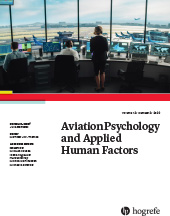Do Personality Traits Predict Training Performance?
The Use of a Personality Questionnaire for Air Traffic Controller Selection
Abstract
Abstract. Most test batteries for the selection of ab initio air traffic controllers (ATCOs) include a personality questionnaire. However, the literature suggests that the relationship between personality and job performance is not straightforward: Correlations are found only for a limited set of personality factors, depend on job characteristics, and are at best small to moderate in size. Moreover, the relationship between personality scores and performance can be curvilinear rather than linear. This research investigates whether a personality test used for the selection of ATCOs predicts subsequent training performance. Training performance was measured in terms of instructor ratings (N = 262) and training outcome (N = 431). The rated training performance correlated positively with general self-efficacy and team orientation, and negatively with negativity and vulnerability. For some traits (i.e., general self-efficacy and rebelliousness), curvilinear relationships were found. A comparison of trait scores between students who had successfully completed and those who had failed the training showed significant differences for 10 of the 17 measured traits, all of which were in the expected direction.
References
(1991). The Big Five personality dimensions and job performance: A meta-analysis. Personnel Psychology, 44(1), 1–26. https://doi.org/10.1111/j.1744-6570.1991.tb00688.x
(2001). Personality and performance at the beginning of the millennium: What do we know and where do we go next? Personality and Performance, 9(1–2), 9–30. https://doi.org/10.1111/1468-2389.00160
(1995). The predictive validity of the EPI and 16PF for military flying training. Journal of Occupational and Organizational Psychology, 68(3), 219–236. https://doi.org/10.1111/j.2044-8325.1995.tb00583.x
(2009). Meta-analysis of personality assessments as predictors of military aviation training success. The International Journal of Aviation Psychology, 20(1), 92–109. https://doi.org/10.1080/10508410903415872
(2014). Uncovering curvilinear relationships between conscientiousness and job performance: How theoretically appropriate measurement makes an empirical difference. Journal of Applied Psychology, 99(4), 564–586. https://doi.org/10.1037/a0034688
(1962). The Sixteen Personality Factor Questionnaire. Institute for Personality and Ability Testing.
(1992). Four ways five factors are basic. Personality and Individual Differences, 13(6), 653–665. https://doi.org/10.1016/0191-8869(92)90236-I
(1995). Domains and facets–hierarchical personality-assessment using the Revised NEO Personality-Inventory. Journal of Personality Assessment, 64(1), 21–50. https://doi.org/10.1207/s15327752jpa6401_2
(1985). The NEO Personality Inventory manual. Psychological Assessment Resources. https://doi.org/10.1037/t07564-000
(2019, November).
The European Air Traffic Control Selection and Assessment System (FEAST) . In Deutsche Gesellschaft für Luftfahrtpsychologie (DGLP)Ed., Proceedings of the 6th symposium of the German Association of Aviation Psychologists (DGLP) (pp. 51–58). DGLP.(1957). The social desirability variable in personality assessment and research. Dryden Press.
(2003, November).
The development and validation of a common FEAST criterion . In EurocontrolEds., Proceedings of the second EUROCONTROL Selection Seminar, Luxembourg (pp. 27–43). EUROCONTROL.. (2000). Integrated task and job analysis of air traffic controllers – Phase 3: Baseline reference of air traffic controller tasks and cognitive processes in the ECAC area (HUM.ET1.ST01.1000-REP-05). EUROCONTROL.
(2003). A model of air traffic controllers’ conflict detection and conflict resolution. Aerospace Science and Technology, 7(6), 409–416. https://doi.org/10.1016/S1270-9638(03)00064-6
(2009). Statistical power analyses using G*Power 3.1: Tests for correlation and regression analyses. Behavior Research Methods, 41(4), 1149–1160. https://doi.org/10.3758/brm.41.4.1149
(2007). G*Power 3: A flexible statistical power analysis program for the social, behavioral, and biomedical sciences. Behavior Research Methods, 39(2), 175–191. https://doi.org/10.3758/bf03193146
(1990). An alternative “description of personality”: The Big-Five factor structure. Journal of Personality and Social Psychology, 59(6), 1216–1229. https://doi.org/10.1037/0022-3514.59.6.1216
(1993). The structure of phenotypic personality traits. American Psychologist, 48(1), 26–34. https://doi.org/10.1037/0003-066X.48.1.26
(2007). Do applicants fake? An examination of the frequency of applicant faking behavior. Personnel Review, 36(3), 341–355. https://doi.org/10.1108/00483480710731310
(2003). The construct of social desirability: One or two dimensions? Personality and Individual Differences, 34(6), 1015–1023. https://doi.org/10.1016/S0191-8869(02)00086-7
(1996). On the relation between personality and job performance of airline pilots. The International Journal of Aviation Psychology, 6(2), 171–178. https://doi.org/10.1207/s15327108ijap0602_4
(2006). Implications of direct and indirect range restriction for meta-analysis. Journal of Applied Psychology, 91(3), 594–612. https://doi.org/10.1037/0021-9010.91.3.594
(2017). Psychological testing: Principles, applications, and issues (9th ed.). Cengage Learning.
(1969). Some relations between personality factors and job performance ratings in radar controllers. Aerospace Medicine, 40, 823–826.
(1970). Performance ratings and personality factors in radar controllers (DOT/FAA/AM-70/14). FAA Office of Aviation Medicine. https://doi.org/10.1037/e413132004–001
(2011). Too much of a good thing: Curvilinear relationships between personality traits and job performance. Journal of Applied Psychology, 96(1), 113–133. https://doi.org/10.1037/a0021016
(2009). Predicting professional success of air traffic control personnel from their personality profile at admission to ab-initio training. The International Journal of Aviation Psychology, 19(3), 235–251. https://doi.org/10.1080/10508410903415872
(2007). In support of personality assessment in organizational settings. Personnel Psychology, 60, 995–1027. https://doi.org/10.1111/j.1744-6570.2007.00099.x
(2013). Predictive validity of a selection procedure for air traffic controller trainees. Aviation Psychology and Applied Human Factors, 3(1), 19–27. https://doi.org/10.1027/2192-0923/a000039
(2004).
Pan-European selection test battery for air traffic control applicants . In K. M. GoetersEd., Aviation psychology: Practice and research (pp. 169–199). Routledge. https://doi.org/10.4324/9781315261843(2006). Correcting for indirect range restriction in meta-analysis: Testing a new meta-analytic procedure. Personnel Psychology, 59(2), 281–305. https://doi.org/10.1111/j.1744-6570.2006.00065.x
(2013). At what sample size do correlations stabilize? Journal of Research in Personality, 47(5), 609–612. https://doi.org/10.1016/j.jrp.2013.05.009
(1993). Contributions of personality measures to predicting success of trainees in the air traffic control specialist non-radar screen program. https://rosap.ntl.bts.gov/view/dot/21349
(1993). Cognitive task analysis of expertise in air traffic control. The International Journal of Aviation Psychology, 3(4), 257–283. https://doi.org/10.1207/s15327108ijap0304_2
(1992). Predictive validity of an automated personality inventory for air force pilot selection. The International Journal of Aviation Psychology, 2(4), 261–270. https://doi.org/10.1207/s15327108ijap0204_2
(1961).
“General Intelligence” Objectively determined and measured . In J. J. JenkinsD. G. PatersonEds., Studies in individual differences: The search for intelligence (pp. 59–73). Appleton-Century-Crofts. https://doi.org/10.1037/11491-006(2003). A personality trait-based interactionist model of job performance. Journal of Applied Psychology, 88(3), 500–517. https://doi.org/10.1037/0021-9010.88.3.500
(1991). Personality measures as predictors of job performance: A meta-analytic review. Personnel Psychology, 44(4), 703–742. https://doi.org/10.1111/j.1744-6570.1991.tb00696.x
(1949). Personnel selection: Tests and measurement techniques. John Wiley.
(2007). Personality and training proficiency: Issues of bandwidth-fidelity and curvilinearity. Journal of Occupational and Organizational Psychology, 80(1), 109–131. https://doi.org/10.1348/096317906X102114
(2014). Big Five facets as predictor of job training performance: The role of specific job demands. Learning and Individual Differences, 29, 1–7. https://doi.org/10.1016/j.lindif.2013.10.008



